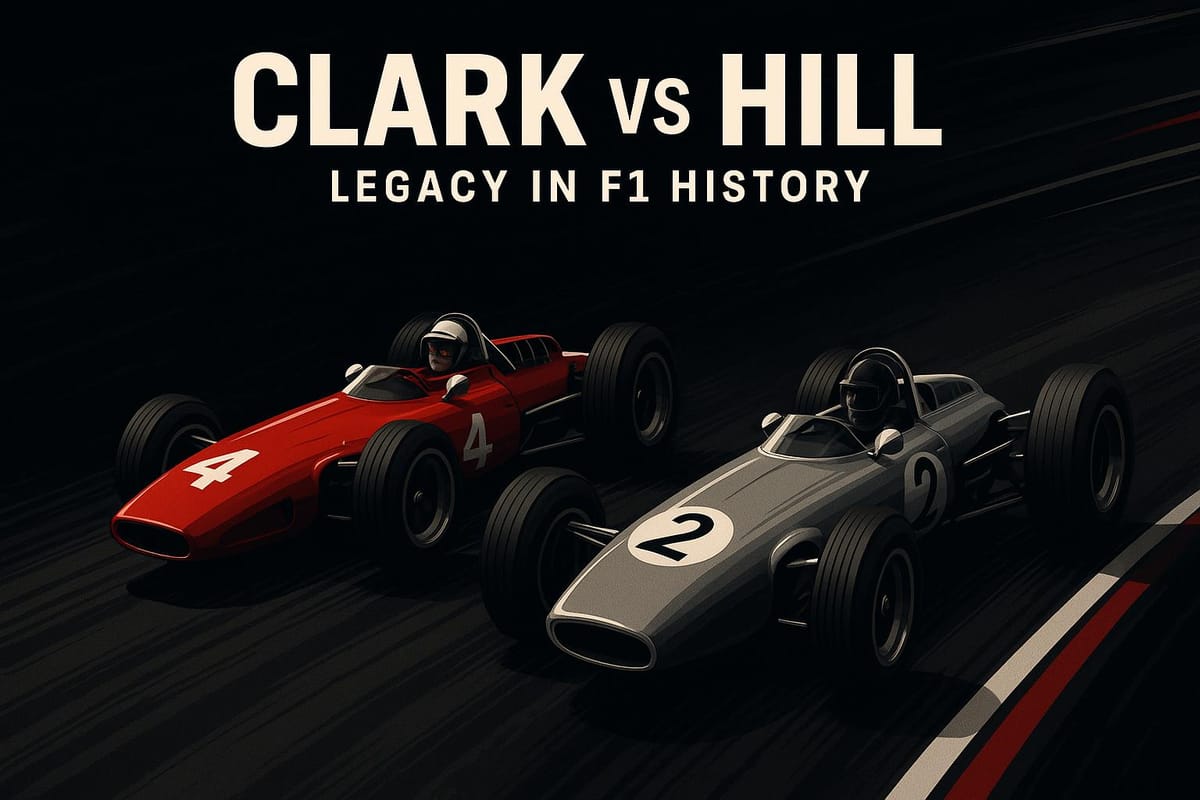Clark vs Hill: Legacy in F1 History
Explore the legendary rivalry between two Formula One icons, their contrasting styles, and their lasting impact on motorsport history.

Jim Clark and Graham Hill defined Formula One's evolution in the 1960s. Their rivalry showcased two contrasting approaches to racing: Clark's natural speed and technical finesse versus Hill's calculated precision and consistency. Both drivers won two championships during this transformative decade - Clark in 1963 and 1965, Hill in 1962 and 1968 - pushing the sport to new heights.
Key highlights:
- Clark's partnership with Lotus and Colin Chapman led to engineering advancements that revolutionized F1.
- Hill's methodical preparation and adaptability brought success across multiple racing formats, including his win at the Indianapolis 500.
- Their battles, such as the 1965 Spa-Francorchamps duel, highlighted their differing strengths and mutual respect.
Clark and Hill's rivalry extended beyond F1, influencing motorsport globally while setting standards for sportsmanship and driver versatility. Their legacy remains a cornerstone of F1 history.
Jim Clark Wins 1962 Belgian Grand Prix with Lotus

Career Achievements and Championship Battles
Clark's unmatched raw speed and Hill's steady, methodical approach created a dynamic rivalry that pushed both drivers to extraordinary levels in Formula One.
Clark vs. Hill: By the Numbers
Clark's knack for dazzling qualifying performances and peak moments stood in stark contrast to Hill's consistent and calculated race strategies. This contrast in styles often defined the seasons and shaped iconic moments on the track.
Defining Seasons and Rivalry Highlights
Their rivalry gained momentum during pivotal seasons, showcasing their unique strengths and cementing their influence on the sport.
In 1962, Hill claimed his first championship with BRM, while Clark was still adapting to evolving car technologies. This season laid the foundation for their future clashes, as their differing techniques began to take center stage.
By 1963, Clark’s dominance with Lotus propelled him into championship contention, even as Hill faced equipment challenges that tested his resilience.
The 1965 season brought a thrilling chapter in their rivalry. Clark captured his second championship, but it wasn’t without Hill’s relentless strategic efforts. Their head-to-head battles that year underscored the razor-thin line between raw speed and calculated precision.
One standout moment came at Spa-Francorchamps, where treacherous conditions showcased their contrasting strengths. Clark’s brilliance in qualifying shone through, while Hill’s careful, deliberate approach kept him in contention.
Their championship duels, defined by Clark’s daring risks and Hill’s measured tactics, left an enduring legacy that continues to echo through the history of Formula One.
Driving Styles, Technical Skills, and Team Relationships
Jim Clark's driving style was a remarkable blend of precision and fluidity, allowing him to tackle even the toughest circuits with ease while getting the most out of his car. His expertise went far beyond just driving fast - Clark had an almost instinctive grasp of car dynamics that played a key role in shaping Lotus' groundbreaking designs during the 1960s. By working closely with Colin Chapman, Clark provided detailed feedback on crucial elements like suspension settings, aerodynamic balance, and engine performance. This collaboration directly influenced the innovative engineering that became a hallmark of Lotus.
Clark's technical know-how also shaped his race strategies. While Graham Hill leaned heavily on careful preparation and steady execution, Clark focused on pushing every component of the car to its limits, often uncovering speed in ways others couldn't. His close relationship with the Lotus engineering team created a powerful cycle of improvement. Insights gained from Clark's performances on the track drove advancements in the garage, and those innovations, in turn, fueled his success on race day.
The rivalry between Clark and Hill highlighted their contrasting strengths. Clark's intuitive technical brilliance clashed with Hill's methodical consistency, with each approach demanding different capabilities from both the driver and the car. Clark's ability to merge his technical feedback with strategic thinking not only defined his racing style but also helped Lotus evolve tactically, setting new standards in Formula 1.
Beyond F1: Multi-Series Racing and Respect
The rivalry between Jim Clark and Graham Hill wasn’t confined to the high-pressure world of Formula One. Both drivers demonstrated their exceptional talent across various racing disciplines, reflecting an era where versatility was as critical as speed.
The Indianapolis 500 and Endurance Racing

Graham Hill’s victory at the Indianapolis 500 remains a standout achievement, proving his ability to adapt to the unique demands of American oval racing. Competing on these tracks required a completely different set of skills and strategies compared to the European circuits he was accustomed to. Hill’s success highlighted his capacity to master these challenges with precision and determination.
Jim Clark, too, made his mark in American racing and endurance events, including Le Mans. His performances in these long-distance races underscored his ability to excel in diverse formats, showcasing a remarkable adaptability that allowed him to thrive in competitive environments far removed from Formula One.
Respect On and Off the Track
What truly set Clark and Hill apart wasn’t just their technical brilliance but the way they carried themselves both on and off the track. Their relationship was built on mutual respect and professionalism, even amid the intense rivalries that defined their careers. While their battles on the circuit were fierce, their contrasting personalities and commitment to fair competition created a sense of camaraderie that resonated with everyone around them - teammates, rivals, and fans alike.
Their dedication to clean racing and sportsmanship became a benchmark for Formula One, demonstrating that fierce competition could coexist with integrity and respect. This bond extended beyond the racing world, leaving a lasting impression on how drivers approach their craft and interact with one another.
The legacy of Jim Clark and Graham Hill goes beyond their achievements in multi-series racing. Their conduct, both as competitors and as individuals, continues to inspire drivers and fans, proving that versatility and respect are timeless qualities that elevate the sport to greater heights.
Impact on Formula One History
The 1960s witnessed the fierce rivalry between Jim Clark and Graham Hill, a competition that reshaped Formula One and set new benchmarks for championship excellence. In 1962, Clark's Lotus introduced a groundbreaking monocoque design. While this innovation brought incredible speed, it was prone to reliability issues. On the other hand, Hill's BRM P57 proved that balancing speed with dependability was the key to success.
Influence on Future Drivers
The lessons learned from this era had a lasting impact on Formula One strategies. Hill's victory at the 1966 Indianapolis 500 showcased the adaptability of Formula One drivers, proving their ability to excel on global platforms.
Clark and Hill in Historical Rankings
Their rivalry extended beyond individual races, earning its place as the 8th greatest in Formula One history. The 1962 championship battle, defined by Clark's engine troubles and Hill's steady performance, remains a classic example of the interplay between technical advancements and reliability. Together, Clark and Hill's contributions played a pivotal role in shaping Formula One during a transformative period in the sport's history.
FAQs
How did Jim Clark and Lotus revolutionize Formula One engineering in the 1960s?
Jim Clark's partnership with Lotus and its innovative mastermind, Colin Chapman, revolutionized Formula One engineering during the 1960s. One of their standout achievements was the introduction of the Lotus 25, the first car to feature a monocoque chassis. This design significantly boosted both safety and structural strength, laying the foundation for how modern F1 cars are built.
Chapman also led the charge in refining aerodynamics and suspension systems. His work included early experiments with ground effect technology and the development of rear suspension struts, which improved both handling and downforce. Clark's extraordinary driving abilities brought these advancements to life on the track, setting new standards in performance and influencing Formula One car design for generations.
How did Jim Clark's and Graham Hill's driving styles differ, and what impact did this have on their F1 legacies?
Jim Clark was celebrated for his flawless precision and his knack for pushing cars to their absolute limits. His late braking and perfectly controlled power slides through corners made him a force to be reckoned with on high-speed circuits, earning him a reputation for effortless mastery behind the wheel. On the other hand, Graham Hill stood out with his calculated and strategic approach, leaning on his wealth of experience and deep understanding of mechanics to consistently deliver strong performances.
Clark’s bold and aggressive style often led to commanding victories, while Hill’s steady and methodical racecraft ensured a level of consistency that was hard to match. Together, their contrasting styles highlighted the wide range of skills needed to excel in Formula One, securing their legacies as two of the sport’s greatest legends.
How did the rivalry between Jim Clark and Graham Hill influence motorsport beyond Formula One, and how did their achievements in other racing formats shape their legacies?
Jim Clark and Graham Hill’s fierce rivalry went beyond the world of Formula One, as both drivers showcased their talents across various motorsport disciplines. Clark wasn’t just a force in F1; he also proved his mettle in sports cars, touring cars, and American open-wheel racing. His success across these formats solidified his reputation as a champion capable of mastering different types of racing.
Hill, meanwhile, achieved something extraordinary: the prestigious Triple Crown of Motorsport. He earned this honor by winning three of the sport’s most iconic events - the Monaco Grand Prix, the Indianapolis 500, and the 24 Hours of Le Mans.
Their achievements across such diverse racing arenas highlighted their extraordinary skill and adaptability, leaving a lasting legacy as two of the most accomplished drivers in motorsport history.




